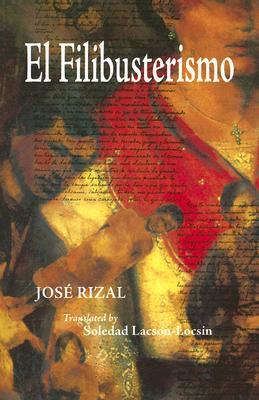
"El Filibusterismo" Summary
By José Rizal
classics | 342 pages | Published in NaN
Estimated read time: 6 min read
One Sentence Summary
"El Filibusterismo" follows the story of Simoun as he seeks revenge against the injustices in Spanish colonial Philippines.
Table of Contents
Introduction
"El Filibusterismo" is a novel written by José Rizal, the national hero of the Philippines. First published in 1891, it is the sequel to Rizal's earlier work, "Noli Me Tangere." The novel is set in the late 19th century during the Spanish colonization of the Philippines and serves as a powerful commentary on the injustices and abuses suffered by the Filipino people under Spanish rule. Through its engaging narrative and compelling characters, "El Filibusterismo" presents a thought-provoking exploration of social, political, and moral issues.
Brief Synopsis
Plot Overview and Setting
"El Filibusterismo" takes place in the Philippines, primarily in Manila, and the surrounding provinces. It follows the story of the protagonist, Simoun, who is actually Crisostomo Ibarra from Rizal's earlier novel, "Noli Me Tangere," but has since adopted a new identity. The novel delves into the continued struggles of the Filipino people under Spanish colonial rule, portraying the injustices, corruption, and abuse of power that permeate society. Simoun, motivated by his desire for revenge and justice, becomes involved in a plot to overthrow the colonial government.
Main Characters
The novel features a range of characters, each with their own complexities and motivations. Some of the main characters include:
| Character | Description |
|---|---|
| Simoun | The protagonist, formerly known as Crisostomo Ibarra. He is a wealthy and enigmatic jeweler who harbors deep-seated anger and seeks revenge against the injustices inflicted upon the Filipino people. |
| Basilio | A young man who has experienced personal tragedies and becomes entangled in Simoun's plans for revolution. He is driven by a desire for justice and a longing for societal change. |
| Isagani | A passionate and idealistic poet who becomes involved in the revolutionary movement. He is characterized by his unwavering commitment to his principles and his love for Paulita Gomez. |
| Paulita Gomez | A young woman who is the object of Isagani's affection. She represents the innocence and purity that Isagani seeks to preserve amidst the turmoil of societal unrest. |
Summary of Different Story Points Over Chapters
Chapter 1-5
The novel opens with Simoun's return to the Philippines, where he uses his wealth and influence to manipulate the ruling class and instigate a revolution. Basilio, now working as a medical apprentice, becomes involved in Simoun's plans after witnessing the injustices suffered by the people. Meanwhile, Isagani, a passionate poet, becomes enamored with Paulita Gomez, and the two become entangled in the unfolding events.
Chapter 6-10
As Simoun's plans for revolution gain momentum, the characters find themselves navigating a web of deceit, betrayal, and moral dilemmas. Basilio grapples with the weight of his involvement in Simoun's schemes, while Isagani becomes increasingly disillusioned with the direction of the revolution. The novel delves into the complexities of their personal struggles amidst the larger societal unrest.
Chapter 11-15
The tension escalates as Simoun's machinations come to a head, leading to a series of dramatic events that test the characters' loyalties and convictions. Basilio is forced to confront the consequences of his choices, and Isagani is faced with a pivotal decision that will shape the course of his involvement in the revolution. The novel masterfully weaves together individual character arcs with the broader narrative of societal upheaval.
Chapter 16-20
In the final chapters, the novel reaches a crescendo as the characters' fates intertwine amidst the backdrop of impending revolution. Simoun's grand plan is set in motion, and the consequences reverberate through the lives of those caught in the tumultuous events. The novel builds towards a powerful climax that highlights the complexities of human nature and the enduring struggle for justice.
Main Events
The novel is punctuated by several significant events that drive the narrative forward:
- Simoun's return to the Philippines and his clandestine efforts to foment revolution.
- Basilio's involvement in Simoun's plans and his moral quandary as he grapples with the consequences of rebellion.
- Isagani's unwavering commitment to his principles and his internal conflict as he witnesses the unfolding chaos.
- The culmination of Simoun's plot and its far-reaching impact on the characters and society as a whole.
Themes and Insights
Themes
"El Filibusterismo" explores a myriad of themes that remain relevant today:
- Colonial Oppression: The novel unflinchingly portrays the oppressive nature of Spanish colonial rule and its devastating effects on the Filipino people.
- Revolution and Justice: It delves into the moral complexities of seeking justice through revolution, highlighting the personal and societal costs of such endeavors.
- Betrayal and Redemption: The novel intricately weaves themes of betrayal and the potential for redemption, underscoring the multifaceted nature of human relationships and motivations.
- Social Injustice: It sheds light on the pervasive social injustices that permeate society, from the exploitation of the marginalized to the unchecked power of the ruling elite.
Insights
Through its exploration of these themes, "El Filibusterismo" offers profound insights into the human condition, the nature of power, and the enduring struggle for justice. It presents a compelling commentary on the complexities of societal upheaval and the indomitable spirit of those who seek to challenge oppression.
Reader's Takeaway
Readers of "El Filibusterismo" are invited to embark on a thought-provoking journey through the tumultuous landscape of colonial-era Philippines. The novel's rich tapestry of characters, intertwined fates, and moral dilemmas offers a captivating exploration of the human experience amidst societal upheaval. It challenges readers to reflect on the enduring pursuit of justice, the complexities of revolution, and the indomitable spirit of those who dare to challenge the status quo.
Conclusion
"El Filibusterismo" stands as a timeless literary masterpiece that continues to resonate with readers, offering a poignant reflection on the tumultuous historical period of Spanish colonial rule in the Philippines. Through its compelling narrative, vivid characters, and incisive exploration of social and political themes, the novel remains a powerful testament to the enduring struggle for justice and the indomitable spirit of those who dare to confront oppression.
El Filibusterismo FAQ
What is the plot of El Filibusterismo?
What themes are explored in El Filibusterismo?
Who are the main characters in El Filibusterismo?
What is the historical significance of El Filibusterismo?
How does El Filibusterismo relate to the author's life?




